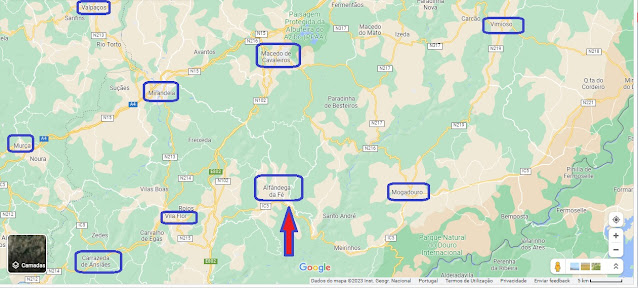ALFÂNDEGA DA FÉ
N 41.34106º; W 6.96103º
Alfândega da Fé is a municipality in northeast Portugal. The population in 2011 was 5,104, in an area of 321.95 km.Physical geography
Although there have been changes throughout its history, Alfândega da Fé has always maintained a few geographic landmarks: the Serra de Bornes in the north, the valley of the Sabor River to the south, the Plateau of Castro Vicente in the east, and the valley of Vilariça in the west. Covering an area of approximately 320 square kilometers, the extent is a synthesis of the Trás-os-Montes region which covers Serras, small plateaus, plains, as well as shallow and deep valleys. The flora is a mixture of natural and introduced species ranging from chestnut, cork, oak, olive, almond, cherry, orange trees, vineyards to intensely cultivated cereal species (namely rye, which is still cultivated in the area, on lands ~1000 meters above sea level).
Climate
The region has a climate that varies between extremes: in the winter, the mountains are covered in snow and temperatures are cold; in the spring, the region is covered by wild flowering plants of enormous diversity with almond, cherry, and apple orchards covered in blooms; in the summer, the dry heat is responsible for an arid environment; and in the fall, the temperate climate transforms the green of tree leaves into several hues.
The municipality retains its 1898 limits, from the Serra de Bornes to the Sabor River, and from the plateau of Castro Vicente to the Vale da Vilariça. Administratively, the municipality is divided into 12 civil parishes (freguesias).
Electricity, indoor plumbing, basic sanitation, and asphalted roads are present and available throughout the municipality, and it is one of the first municipalities to close its public dump. Although the community is not free from problems, it does have many services that are uncommon in the region, primarily due to its distance from the district capital. Its Centros de Saúde (health centers), along with private initiatives, have made it one of the more dynamic municipalities in the country, providing local service without unnecessary trips to distant hospitals.
Economy
With about 7000 residents, the municipality still finds agriculture its main economic stimulus. Although growth has been difficult (due to changes caused by market competition, the introduction of industrialization, and lack of a national agriculture policy), most of its citizens still identify themselves as farmers. The lack of a serious quality certification for local biological products, such as olive oil, almonds, chestnuts, fruits, cheeses, local smoked meats/sausages, sweets, competes, and traditional liqueurs, has generally been a complaint of local farmers trying to expand their businesses.
Several handicrafts from the traditional culture of the region are locally produced: embroidery and quilt-making, basket-weaving, metal-smithing, shoe-making, and sewing, which had been abandoned in the modernization of Portugal. One of these, the creation of fine cloths from silkworms, was common in the region. These traditions have been slowly explored for their economic and tourist-friendly benefits. This reemergence of traditional handicrafts has, over the past decades, added to the tertiary sector of the economy, along with the expansion of commerce, hotels, and small industries associated with tourism. The construction of a new municipal market has improved local commerce, in addition to the expansion of the medieval fair which has been a lure for tourists, the Recinto da Feira and Feira da Cereja.
Industrial activities are concentrated in an industrial zone within the main city of Alfândega. Agriculture, the base of the economy, still requires many improvements, including the expansion of dams to cover larger areas (another two projects have been planned). Tourism, although gaining importance recently in the region, has been aided by the construction of a modern hotel in the Serra de Bornes (Estalagem Senhora das Neves), new restaurants, and the expansion of hunting lodges (for clubs, associations, and huntsmen). The opening of the Parque de Usos Múltiplos (Multi-Use Park) offers locals and visitors a variety of nature activities (e.g. camping).














































